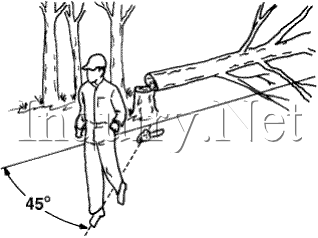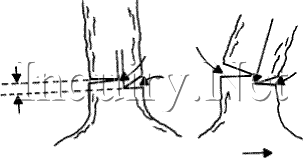Felling The Tree
 There are many things to do and consider before starting to fall a tree.
Examine the tree; which way does it lean and how is it weighted? This has a lot
to do with the direction it will fall. Is that area clear of people, power and
utility lines, or anything that would be hit? Clear the area of people,
vehicles, branches and debris.
There are many things to do and consider before starting to fall a tree.
Examine the tree; which way does it lean and how is it weighted? This has a lot
to do with the direction it will fall. Is that area clear of people, power and
utility lines, or anything that would be hit? Clear the area of people,
vehicles, branches and debris.
If an electric power line is in the vicinity of the tree, don't attempt to work on the tree unless you are absolutely certain that it will not interfere with the electric line. If the tree must be removed and you suspect there will be a problem, call the power supplier; they have the expertise to do it safely.
Will the wind have an effect on how and where the tree will fall? What about other trees? A very dangerous hazard results when the cut tree entangles with another and does not fall completely. Determine the direction of fall carefully as well as an escape route. Don't wait until the tree is falling to decide which way you should move to avoid being hit.
Always plan an escape route to a safe location from where you are working. Your path of retreat should be along a line approximately 45 degrees from the direction of fall of the tree. This is most important when cutting (falling) trees. Select a place to set the chain saw; it is never recommended to run with a chain saw in your hand, operating or not. Turn off the chain saw and set it down; it is replaceable -- you are not.

Plan the cuts carefully. Smaller trees (up to a 6 inch diameter) may be cut clear through with one pass. Larger trees may require a series of cuts as shown in the drawing to the left.
Start with a 45 degree notch on the side that the tree will fall towards. Cut the bottom of the notch first, about one third of the way through the diameter. The second cut is made at a 45 degree angle that will meet the depth of the first cut. The felling cut should be made from the opposite side, about 2 inches higher than the floor of the notch. Do not cut all the way through but leave a hinge that will keep the tree from kicking back and upward as it falls. The hinge will be about 1/8 to 1/6 of the diameter where you are cutting but it may vary depending on when the tree starts to fall.
When the tree starts to fall, it is time to shut off the chain saw, set it down safely (don't throw it), and leave on your planned escape route. Do not return to the site until the tree is down and no longer moving. If the tree should roll, let it; one person cannot stop or control a moving tree.
If a tree happens to be so well balanced that it does not fall after a felling cut has been made, two wedges can be used to start the fall and influence its direction. Always use two wedges and a sledge that has a face 1/3 larger than the face of the wedge.
Plastic wedges are safer than metal since they will not damage the saw teeth or chain. Always remove the chain saw when wedges are being driven into the cut. Strike the wedge carefully since a careless blow may cause the wedge to pop out of the cut and allow the tree to fall backward, on you.
Never use an axe as the wedge or driver; the head of the axe may shatter and you could be injured by pieces of it. If cutting must be continued, insert the chain saw into the cut very carefully since the conditions are extremely dangerous.
Limbing The Tree
Be sure that the fallen tree is stable and will not move as you work. Examine the situation at every limb to be removed. Be certain that the limb will not bind against the saw. Cut on the opposite side of the tree trunk whenever possible, this keeps the trunk between you and the saw. Never stand on the downhill side when removing limbs. Always keep in mind that the tree trunk may roll as limbs are removed. Watch for limbs that may spring out when they are cut due to the released tension. These limbs can cause injury.
Larger limbs may require more than one cut to be removed safely. Plan the cuts so that there will be no binding. Remember that stored energy can cause a cut to pinch the blade and immobilize your saw. Wedges can be used as previously mentioned. Always plan an escape route when removing large limbs since they may roll when they become free of the tree trunk.
Key Safety Tips
| Always avoid making cuts with the saw between your legs, always cut with the saw to the outside of your legs. | |
| Don't stand on a log and saw between your feet. | |
| Always stand to one side of the limb you are to cut, never straddle it. | |
| Always keep in mind where the chain will go if it breaks, never position yourself or other people in line with the chain. | |
| Keep the chain out of the dirt, debris will fly, the teeth will be dulled and the chain life shortened considerably. |
Axe Safety
| Boots should ALWAYS be worn when using any axe. | |
| When using an axe a designated chopping area should be cordoned off. This should be in an area where there are few, if any, overhead branches. | |
| Spectators should always be kept at least two axe lengths away. | |
| NEVER chop on the ground always use a chopping block, and aim at where the branch is supported by the block. | |
| NEVER use the axe if you are tired. | |
| The axe should always be masked when finished with or not in use. This can be done with a leather (or similar material) cover, or by being left in a log. When burying the axe-head, make sure that the axe handle is never overhanging the length of the log. | |
| When the axe has to be transported from one area to another, it should be masked (obviously not within a log) and should be carried so that the head is in your hand with the blade facing forwards and the toe facing towards the sky. | |
| NEVER use an axe with a split haft. Always replace a damaged haft with a new one - NEVER attempt to repair a haft however slight the damage. |